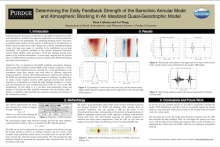Determining the Eddy Feedback Strength of the Baroclinic Annular Mode and Atmospheric Blocking In An Idealized Quasi-Geostrophic Model
Dean
Calhoun
Purdue University
Poster
Understanding the dynamical contributions to atmospheric blocking from large-scale atmospheric circulation has important implications for disaster preparation and mitigation in the midlatitudes. Yet, predicting blocking events using short-to-medium-range weather forecast systems is difficult due to the persistence of blocks beyond synoptic time scales. Despite this, a theory connecting blocking events with large-scale modes of variability in the midlatitudes has not been established. One potential candidate is the recently discovered Baroclinic Annular Mode (BAM), which describes a 20-30 day regularly pulsing storm pattern in the Southern Hemisphere. A recent study suggests that the positive phase of BAM enhances blocking occurrence, implying that BAM and blocking may share similar dynamics. Inspired by this, we hypothesize that BAM modulates atmospheric blocking, and synoptic eddy feedback sustains BAM, which would be conducive to block formation. Eddy feedback processes describe how small perturbations to the atmospheric mean flow interact with each other to influence large-scale dynamical patterns. Various eddy feedback processes influence the strength of the BAM and blocking, yet quantifying the influence of any particular process remains a challenge. We adopt a linear response function (LRF) approach that has been recently proposed as a framework to evaluate the eddy feedback strength to a climate state and determine the most excitable dynamical mode. We adopt a quasi-geostrophic (QG) model which contains essential dynamical and physical processes for BAM and blocking while ignoring those of secondary importance. We will calculate a LRF for the model in two climatological basic states–corresponding to the positive and negative phases of BAM–by repeatedly running each model, applying a different weak localized forcing each time, and systematically analyzing the outputs compared to unforced runs using matrix computations. Using the LRF, we will show the response of synoptic eddies and blocking events to an imposed BAM state.

Poster file
Calhoun_Dean_blocking_poster.pdf
(2.08 MB)
Meeting homepage
